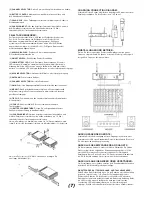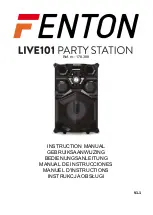
IINSERTE BATERIAS EN EL MICROFONO /
TRANSMISOR DE PETACA:
• Pulse para abrir el compartimiento de las baterías e inserte las mismas
de acuerdo con la polaridad marcada (+)(-). El transmisor puede ahora
funcionar correctamente.
• Al pulsar el interruptor de encendido ON/OFF, el LED para flash
momentáneamente. Si las baterías están correctas, el LED flash
una vez. Si el LED queda encendido, indica que la batería esta baja. Si el
LED no hace flash, la batería esta agotada o la polaridad no es la correcta.
• Coloque de Nuevo la tapa de las pilas.
AJUSTANDO EL TRANSMISOR DE MANO:
• Encienda el aparato y compruebe la frecuencia y volumen.
• Encienda el amplificador donde este conectado.
• Compruebe el micrófono y ajuste niveles en el micro y amplificador.
• Cuando utilice una conexión estándar de audio 1/4" en la entrada MIC
IN de su mezclador o amplificador, por favor ajuste el volumen a lo que
en un reloj serian la 1 que producirá una salida aproximada de 77mV.
• Cuando utilice una conexión estándar de audio 1/4" en la entrada LINE
IN de su mezclador o amplificador, por favor ajuste el volumen a
el nivel máximo que producirá una salida aproximada de 770mV.
AJUSTANDO EL TRANSMISOR DE PETACA:
CONECTANDO UN MICROFONO:
• Abrir la tapa de pilas. Pulse el selector MIC/LINE a “MIC” y use el
destornillador incorporado para ajustar la ganancia a la posición apropiada.
• Conecte el jack mini XLR del final del micrófono a al entrada del
transmisor de petaca.
• Encienda su fuente de sonido.
• Compruebe el micrófono y ajuste niveles en el micro y amplificador.
CONECTANDO UN INSTRUMENTO:
• Abrir la tapa de pilas. Pulse el selector MIC/LINE a “LINE” y use el
destornillador incorporado para ajustar la ganancia a la posición apropiada.
• Conecte el jack mini XLR del cable opcional para instrumentos a al
entrada del transmisor de petaca.
• Encienda su fuente de sonido.
• Compruebe el instrumento musical y ajuste niveles en el transmisor y
amplificador.
COMPROBACION DE PROBLEMAS:
NO HAY SONIDO:
Compruebe la alimentación en receptor y transmisor.
Compruebe que receptor y transmisor están en la misma frecuencia.
Compruebe las conexiones con la fuente de sonido.
Compruebe que el transmisor no este muy lejos o el squelch muy alto.
Compruebe que el receptor no este muy cerca de objetos metálicos ni interferencias.
INTERFERENCIAS SONORAS:
Compruebe la colocación de la antena.
Si utiliza dos micrófonos compruebe que las frecuencias no se interfieren.
Compruebe si recibe interferencias de otras Fuentes inalámbricas,
TV, radio, etc.
DISTORSION:
Compruebe el volumen del receptor por si es demasiado alto o bajo.
Compruebe si recibe interferencias de otras Fuentes inalámbricas,
TV, radio, etc.
ESPECIFICATIONES:
UF-1264:
Frequency range:.........................................USA: 682-698MHz, Europe: 854-865MHz
Case..................................................................................................Half 19” EIA Case
Receiving System................................................................................PLL synthesized
Receiving Mode..........................................64CH, Single Channel, Switching diversity
Frequency Stability.........................................................................................+/- 0.05%
Receiving Sensitivity......................................................At 8 dBuV over 80dB S/N ratio
Image & Spurious Rej. .........................................................................80 dB minimum
Selectivity............................................................................................................> 50dB
Modulation Mode......................................................................................................FM
IF Frequency1st:.................................................................1st: 56MHz, 2nd: 10.7MHz
Dynamic Range...................................................................................................>96dB
Tone Signal...................................................................................................32.768KHz
S/N Response.....................................................Over 94dB, at 48KHz deviation and
60dBuV antenna input
AF Response...........................................................................50Hz to 15KHz(+/-3dB)
T.H.D. .....................................................................................................1%(at 1KHz)
Power Supply............................................................................................DC 12 ~ 18V
Audio Output.................................................................Balanced & unbalanced output
Current Consumption..........................................................................260mA +/- 10mA
Dimension(mm)WxHxD.........................................................................210 x 44 x 165
UF-2064
Frequency range:........................................USA: 682-698MHz, Europe: 854-865MHz
Case..................................................................................................Half 19” EIA Case
Receiving System................................................................................PLL synthesized
Receiving Mode.....................................................64CH, Dual Channel, Non-diversity
Frequency Stability.........................................................................................+/- 0.05%
Receiving Sensitivity......................................................At 8 dBuV over 80dB S/N ratio
Image & Spurious Rej. ........................................................................80 dB minimum
Selectivity............................................................................................................> 50dB
Modulation Mode......................................................................................................FM
IF Frequency1st:..................................................................1st: 56MHz, 2nd: 10.7MHz
Dynamic Range..................................................................................................>96dB
Tone Signal...................................................................................................32.768KHz
S/N Response...................Over 94dB, at 48KHz deviation and 60dBuV antenna input
AF Response............................................................................50Hz to 15KHz(+/-3dB)
T.H.D. ........................................................................................................1%(at 1KHz)
Power Supply.............................................................................................DC 12 ~ 18V
Audio Output.................................................................Balanced & unbalanced output
Current Consumption.........................................................................260mA +/- 10mA
Dimension(mm)WxHxD..........................................................................210 x 44 x 165
FM-64
Mic Type..........................................................................64CH, Handheld microphone
Frequency range:.........................................USA: 682-698MHz, Europe: 854-865MHz
RF Power Output.......................................................................................10mW(max.)
Oscillation Mode..................................................................................PLL synthesized
Frequency Stability.......................................................................................+/- 0.005%
Maximum Deviation...............................................+/-48KHz with limiting compressor
Spurious Emission......................................................>60 dB below carrier frequency
T.H.D. ..............................................................................................1%(at 1KHz)
Chargeable Battery..................................................DC 3V(1.5v x 2 AA size batteries)
Tone Key...................................................................................................32.768KHz
Mic Unit..............................................................................Uni-directional dynamic unit
LED Indicator...............................................................Power ON-OFF and low battery
Current Consumption...................................................................................65 +/- 5mA
Dimension(mm)WxHxD....................................................................................267 x 55
FB-64:
Mic Type...........................................................................64CH, Bodypack transmitter
Frequency range:........................................USA: 682-698MHz, Europe: 854-865MHz
RF Power Output......................................................................................10mW (max.)
Oscillation Mode..................................................................................PLL synthesized
Frequency Stability.......................................................................................+/- 0.005%
Maximum Deviation.................................................+/-48KHz with limiting compressor
Spurious Emission......................................................>60 dB below carrier frequency
T.H.D. ........................................................................................................1%(at 1KHz)
Chargeable Battery.................................................DC 3V (1.5v x 2 AA size batteries)
Tone Key.......................................................................................................32.768KHz
Mic Unit...........................................................................Uni-directional condenser unit
LED Indicator...............................................................Power ON-OFF and low battery
Current Consumption...................................................................................65 +/- 5mA
Dimension(mm)WxHxD..............................................................................66 x 97 x 25
DISEÑO Y ESPECIFICACIONES SUJETOS A CAMBIO SIN PREVIO AVISO.
(11)
Summary of Contents for UF-1264 HL
Page 2: ...FREQUENCY CHART AS OF NOVEMEBR 1ST 2008 ...
Page 3: ...UF SERIES 2 ...

































